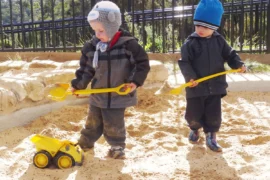How to Make Play Doh at Home: A Fun and Easy Guide for Parents
Hello there, creative parents and little explorers! Are you ready to dive into a world of color and imagination right from your kitchen? Play Doh is not just a fantastic tool to spark creativity in your children, but it’s also a wonderful way to spend quality time together. In this step-by-step guide, we’ll show you how to make non-toxic, homemade Play Doh that’s safe, easy, and most importantly, fun for all ages!
Why Make Your Play Doh at Home?
Making Play Doh at home has a bucket load of benefits. It’s cost-effective, you can customize colors and textures, and it’s free from any chemicals you might not want your kiddos playing with. Plus, it’s a marvelous sensory experience that contributes to your child’s development. So, let’s get our hands doughy!
Ingredients You’ll Need
- 1 cup of all-purpose flour
- 1/4 cup of salt
- 2 tablespoons cream of tartar (for elasticity)
- 1 tablespoon vegetable oil
- 1 cup of water
- Food coloring (any colors you like!)
- Optional: Essential oils for scents or glitter for a sparkly touch
Step-by-Step Guide to Making Your Play Doh
Gather Your Materials
First things first, let’s get all your ingredients and tools ready. You’ll need a mixing bowl, a saucepan, and some measuring cups and spoons. Make sure your little helpers are ready to go with their aprons on – it’s about to get colorful!
Mix the Dry Ingredients
In your bowl, whisk together the flour, salt, and cream of tartar. These are the base ingredients for your dough and ensure it will last for playtimes to come!
Add the Wet Ingredients
Now, make a little well in the center of your dry ingredients and add in the water and vegetable oil. If you’re planning on making just one color of Play Doh, this is the time to add your food coloring. Start with a few drops and increase until you get the hue you desire.
Cook Up the Dough
Transfer your dough mixture into a saucepan and heat it gently over medium heat. You’ll need to stir it consistently to prevent sticking. After several minutes, the mixture will start to thicken and come together. Once it starts forming a ball and pulls away from the sides of the saucepan, you’ve hit the Play Doh jackpot!
Cooling and Kneading
Remove the dough from the heat and let it cool down on a piece of parchment or wax paper. After it’s cool enough to handle, it’s time to get kneading. This will help make your homemade Play Doh nice and smooth. If you’re adding glitter or essential oils for scent, knead them into the dough now.
Divide and Color (If Needed)
If you’re making multiple colors from one batch, divide your dough into equal parts. Flatten each piece and add a couple of drops of a different food coloring to each. Fold the dough over the food coloring and knead until the color is evenly distributed. Remember, this part can get a bit messy, so keep those aprons on!
There you have it, folks! A simple, straightforward process to making your very own Play Doh at home. But wait, this is just the beginning! We’ll continue with tips on how to store your dough, plus some fantastic play ideas to keep those little hands busy and those big imaginations running wild. Stay tuned for the next section, where we discover even more Play Doh magic!

How to Make Play Doh at Home: A Fun and Easy Guide for Parents
Five Essential Tips for Parents Before Making Play Doh
Before we roll up our sleeves, let’s go over five helpful tips every parent should know before starting this delightful DIY Play Doh adventure:
- Safety First: You’ll be cooking the dough on the stove, so if your little helpers want to be involved in this step, always supervise them closely. Discuss kitchen safety and the importance of not touching hot surfaces.
- Quality Ingredients: Use high-quality food coloring to achieve vibrant dough without staining hands. Choose good vegetable oil to avoid a greasy texture, and opt for fresh cream of tartar for elasticity.
- Consistency Is Key: Pay close attention to the dough’s consistency while cooking. If it’s too sticky, sprinkle in a little more flour. If too dry and crumbly, add a splash of water.
- Embrace the Mess: Making Play Doh is a messy affair, and that’s okay! Use washable coverings on surfaces, have paper towels at hand, and dress your junior chefs in clothes that can get dirty.
- Customization: Let your children pick their favorite colors and extras such as glitter or scents. This part of the process allows their creativity to shine through even before the playing begins.
Storing Your Play Doh
To keep your homemade Play Doh fresh and ready for the next play session, store it in an airtight container or a resealable plastic bag. Keep it in a cool, dry place. If the dough begins to dry out, kneading in a bit more water can sometimes rejuvenate it.
Creative Play Ideas
Once you’ve made your Play Doh, the possibilities are endless! Encourage your kids to roll it, press it, squish it, and shape it into whatever they can dream up. Provide them with cookie cutters, rolling pins, plastic knives, and other safe tools to enhance their play experience. It’s not only about having fun; they’re building fine motor skills and boosting their cognitive development too!
Cleaning Up
After playtime, some Play Doh may get onto carpets or furniture. If it dries up, it can generally be vacuumed or picked off easily. For stubborn residues, a gentle rub with warm, soapy water usually does the trick.
And there you have it! Your guide to having an entertaining and educational activity with your children. Not only have you crafted a creative toy together, but you’ve also made memories that will shape their childhood joyfully. Now it’s time to mold, craft, and create many adventures with your very own homemade Play Doh!
. For more information see here
Disclaimer
The articles available via our website provide general information only and we strongly urge readers to exercise caution and conduct their own thorough research and fact-checking. The information presented should not be taken as absolute truth, and, to the maximum extent permitted by law, we will not be held liable for any inaccuracies or errors in the content. It is essential for individuals to independently verify and validate the information before making any decisions or taking any actions based on the articles.




